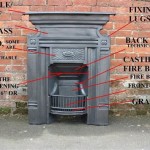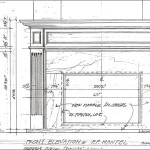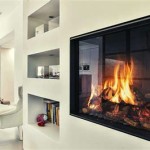Brick Tile For Fireplace Surround: A Timeless and Functional Choice
Brick tile, employed as a material for fireplace surrounds, presents a compelling combination of aesthetic appeal and practical advantages. Its enduring style resonates with various interior design themes, from rustic and traditional to modern and industrial. Beyond aesthetics, brick tile offers significant functional benefits, including heat resistance, durability, and relatively straightforward installation.
The selection of the appropriate brick tile for a fireplace surround necessitates careful consideration of aspects such as the desired aesthetic, the dimensions of the fireplace, and the overall design of the room. Furthermore, adherence to relevant building codes and safety regulations is of paramount importance to ensure a safe and compliant installation.
Aesthetic Versatility and Design Considerations
The inherent aesthetic of brick tile provides a wide range of design possibilities for fireplace surrounds. Its natural texture and color variations contribute to a visually rich and characterful surface. Manufacturers offer brick tile in numerous styles, colors, and textures, allowing for customization to suit diverse architectural preferences. Reclaimed brick tile, in particular, introduces a sense of history and authenticity, while newer brick tile can offer a more consistent and contemporary appearance.
When choosing brick tile, consideration should be given to the size and shape of the individual tiles. Larger tiles can create a more streamlined and modern look, while smaller tiles can evoke a more traditional or rustic feel. The grout lines between the tiles also play a significant role in the overall aesthetic. A contrasting grout color can accentuate the brick pattern, while a matching grout color can create a more subtle and unified appearance. The arrangement of the brick tile, such as a running bond, herringbone, or stacked pattern, can further influence the visual impact of the fireplace surround.
The color palette of the brick tile should harmonize with the existing decor of the room. Red brick, a classic choice, complements warm color schemes and traditional interiors. White or gray brick offers a more neutral and contemporary aesthetic that can be easily incorporated into a variety of design styles. Darker brick tones can add a sense of drama and sophistication to the space.
Functional Advantages: Heat Resistance, Durability, and Maintenance
Brick, by virtue of its composition and manufacturing process, possesses excellent heat resistance. This is a crucial attribute for a fireplace surround, as it needs to withstand the high temperatures generated by the fire without cracking, warping, or otherwise deteriorating. The thermal mass of brick also contributes to its ability to absorb and radiate heat, helping to maintain a comfortable temperature in the room.
Durability is another significant advantage of brick tile. Its robust nature makes it resistant to scratches, dents, and other forms of wear and tear. This is particularly important for a fireplace surround, which is often subjected to daily use and potential impact. The longevity of brick tile means that it can maintain its aesthetic appeal for many years with minimal maintenance.
Maintenance of brick tile is relatively straightforward. Regular cleaning with a mild detergent and water is typically sufficient to remove dust and grime. For more stubborn stains, a specialized brick cleaner may be necessary. Sealing the brick tile can provide additional protection against staining and moisture absorption. The porous nature of brick can make it susceptible to water damage if not properly sealed, especially in areas with high humidity. Proper sealing also facilitates easier cleaning and prevents the accumulation of dirt and grime within the brick's pores.
Installation Considerations and Safety Regulations
The installation of brick tile for a fireplace surround requires careful planning and execution. Proper surface preparation is essential to ensure a secure and long-lasting installation. The substrate should be clean, level, and structurally sound. A layer of cement board or a similar backer board is typically recommended to provide a stable and moisture-resistant surface for the brick tile.
The brick tile should be adhered to the substrate using a high-quality mortar specifically designed for brick or stone installation. The mortar should be applied evenly and consistently to ensure proper adhesion. Spacers should be used to maintain uniform grout lines. After the mortar has cured, the grout can be applied to fill the spaces between the tiles. The grout should be carefully worked into the joints and then wiped clean to remove any excess material.
Adherence to local building codes and safety regulations is paramount when installing a fireplace surround. These regulations typically address such issues as clearances to combustible materials, fireproofing requirements, and ventilation. It is essential to consult with a qualified building inspector or contractor to ensure that the installation complies with all applicable regulations. Specifically, the distance between the fireplace opening and any combustible materials, such as wood framing or drywall, must meet the minimum requirements specified in the building code. The use of non-combustible materials, such as cement board or metal studs, may be necessary to achieve the required clearances.
Consideration should also be given to the fireplace's specific requirements. Some fireplaces require a non-combustible hearth extension in front of the opening to protect the floor from sparks and embers. The size and configuration of the hearth extension are typically specified in the building code and the fireplace manufacturer's instructions. Furthermore, proper ventilation is essential to ensure the safe and efficient operation of the fireplace. The chimney should be regularly inspected and cleaned to remove any creosote buildup, which can pose a fire hazard.
Before commencing the installation, it is prudent to create a detailed plan that outlines the dimensions of the fireplace surround, the layout of the brick tile, and the location of any electrical outlets or other features. This plan will serve as a roadmap for the installation and will help to ensure a successful outcome. It is also advisable to dry-fit the brick tile before applying the mortar to ensure that the layout is aesthetically pleasing and that all cuts and adjustments are made before the tiles are permanently installed.

How To Tile Over Brick Fireplace Surround Story Stefana Silber

I Added Faux Brick Wallpaper To Our Fireplace The Wicker House

Glazed Brick Fireplace Plays It Cool Fireclay Tile

Hot Fireplace Tile Trends Bedrosians Stone

How To Tile Over Brick Fireplace Surround

How To Tile A Fireplace Even If It S Brick The Handyman Daughter

Lauriechampdesign Com Fireplace Remodel Home Surrounds

How To Tile A Brick Fireplace Jenna Kate At Home

Walls Ceilings And Fireplaces Inglenook Brick Tiles Pavers Thin Tile Floor

Fireplace Mantel Surround Brick Veneer Sunny Side Design








